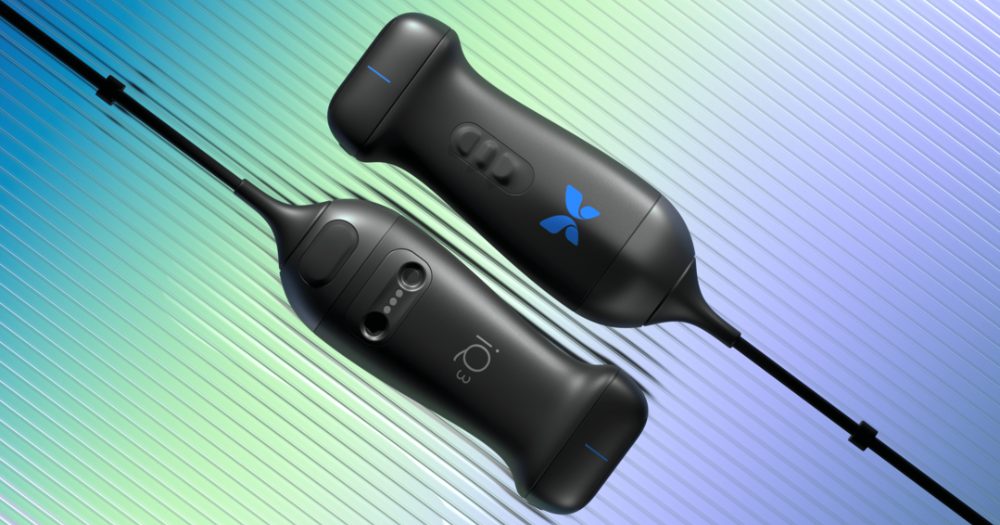Butterfly Network launches next-gen Butterfly iQ3

Maker of portable ultrasound tech Butterfly Network launched its third-generation handheld point-of-care ultrasound (POCUS) system, Butterfly iQ3, which received FDA clearance last month. Powered by the company's most advanced semiconductor chip with a data transfer rate that is double that of its predecessor, Butterfly iQ3 offers "unparalleled image quality" and faster micro-beamforming for advanced 3D capabilities - iQ Slice and iQ Fan.
The new POCUS system also features a novel "no focus" rubber lens, enabling providers to intuitively identify anatomy, observe small structures, and ultimately - make more confident diagnostic decisions.
What's new?
Launching on Butterfly iQ3 are two new, advanced 3D imaging capabilities designed to make image capturing easier: iQ Slice and iQ Fan. These tools join Butterfly's existing robust feature list of over 20 anatomical presets, six imaging modes (B-Mode, M-Mode, Color Doppler, Power Doppler, Pulsed-Wave Doppler, and Biplane Imaging) and collection of artificial intelligence (AI) and advanced imaging tools (e.g, Auto Bladder Volume Capture, Auto B-Line Counter, NeedleViz, and a rich set of Calculation tools).
- Butterfly iQ Slice: The world's first automated, sequential ultrasound capture mode on a handheld device, made uniquely possible by Butterfly's proprietary Ultrasound-on-Chip technology. iQ Slice automatically steers the beam to scan an organ and capture up to 46 ultrasound slices at a time across a wide angle. The imaging mode is designed to make it easier and faster to acquire excellent images without skilled maneuvering. These files can either be immediately read and measured at the bedside by skilled scanners, or for those less experienced, can be sent to a specialist for further review - similar to the workflow of a CT or MRI.
- Butterfly iQ Fan: A dedicated lung tool that further builds on the core iQ Slice technology to allow providers to benefit from real-time, back-and-forth virtual fanning, making it easier to visualize A-lines and other lung conditions. With iQ Fan the user no longer needs to manually fan the probe, and can just focus on analyzing the images.
The new shape of ultrasound: enhanced comfort and efficiency.
Butterfly iQ3 also features a new user-centric ergonomic design that is smaller, lighter and better distributed, and with even stronger battery:
- 17% smaller probe face allows for better intercostal access for cardiac and lung imaging, as well as vascular access.
- 7% shorter probe with ergonomic weight distribution designed to reduce the physical strain on scanners and ensure better control and maneuverability, which allows for more precise and comfortable scans.
- 3 configurable control buttons can be tailored for functionality, allowing for user-friendly, seamless navigation, quick scans and interpretations, saving critical time during diagnoses.
- 2.5x faster charge time than Butterfly iQ+ and up to 2 hours of thermal run time for outstanding continuous scanning.
On the record
"Butterfly iQ3 is a pivotal moment in Butterfly's trajectory, further validating the company's initial hypothesis that semiconductor-based digital ultrasound is not only viable, but the future of all ultrasound," said Joseph DeVivo, Butterfly Network's President, CEO and Board Chairman. "With the introduction of iQ3, we're witnessing a paradigm shift in ultrasound. iQ3 sets a new standard where digital image quality matches that of traditional handheld devices, and even certain carts. This device will attract more seasoned POCUS experts to choose Butterfly and support new learners to gain confidence and competency through artificial intelligence and advanced imaging tools."
"The next-generation P4.3 chip we developed with TSMC, the world's leading semiconductor foundry, is the foundation for the Butterfly iQ3 hardware platform. From the micron-sized MEMS1 that transmit and receive ultrasound to the electronics and mechanical heat dissipation, we've improved device performance across the board," said Andrei Stoica, PhD, CTO of Butterfly Network. "Our customers will have a seamless experience that's fully integrated across hardware, mobile app, and enterprise software."
"With Butterfly iQ3, we set out to give clinicians the clear leading solution in point-of-care ultrasound. We built this device to meet the needs of the end user every step of the way, whether they're an advanced scanner or just starting out, and we achieved this," added Butterfly Network's Chief Medical Officer, John Martin, MD. "We delivered a probe that will always be ready for them. Immediate boot up to clear imaging, long run time, fit-in-hand comfort, customizable controls, and rapid charging... all at a price that's still below incumbents."
The context
The launch of Butterfly iQ3 follows Butterfly's release of ScanLab last month, a separate AI-powered educational application for ultrasound scanning practice that is available for download to all Butterfly members at no additional cost, and is compatible with Butterfly iQ3, as well as prior generations.
Butterfly iQ3 is now commercially available to healthcare providers in the United States for $3,899 plus membership. Information on the device's global availability hasn't been shared, but chances are - it will be released in other markets (including MENA) later this year.
💡Did you know?
You can take your DHArab experience to the next level with our Premium Membership.👉 Click here to learn more
🛠️Featured tool
 Easy-Peasy
Easy-Peasy
An all-in-one AI tool offering the ability to build no-code AI Bots, create articles & social media posts, convert text into natural speech in 40+ languages, create and edit images, generate videos, and more.
👉 Click here to learn more


